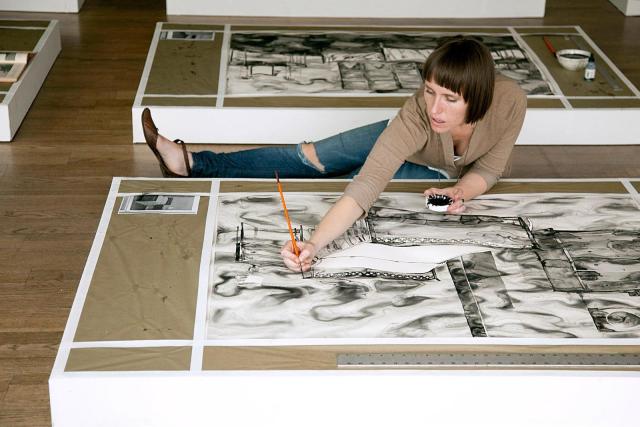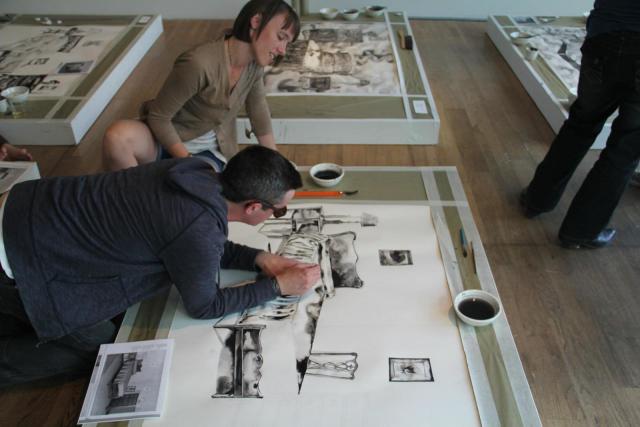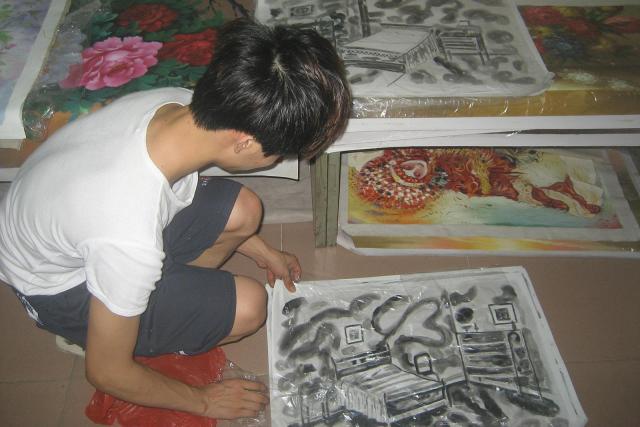Painted in Portland, Copied in China

Former Golden Rule Gallery curator, painter and interdisciplinary artist Wynde Dyer wondered: "What would my artwork look like if it were produced assembly-line style? How about if my friends made reproductions of it? Or if I ordered reproductions from a factory in China?" Many artists might indulge in such speculation, but few follow through with a full-fledged, public, process-based art project. Having just completed her Production/Reproduction series at Pioneer Square Mall’s Place Gallery and still selling off the spoils, Dyer walks us through the play-by-play and shares some of her findings.
PHASE 1: Watercolor still-life painter forces herself into mass-production mode.
I expected that working a 40-hour work week, with rigorous performance metrics (i.e. forcing myself to paint nine dressers in one day, then nine beds the next, etc.), in a one-woman assembly-line would increase efficiency, but decrease the effectiveness of the pieces. What I discovered is that specialized assembly line work (i.e. doing the same micro task over and over) increased efficiency and effectiveness on tasks I do not, as a rule, enjoy doing. Boring grunt work stuff like measuring and cutting paper, taping off borders, marking grid lines on source material and paper, etc., all went SO much faster and was SO much easier, and the results were SO much tidier, more accurate, and working environment was, overall, much more functional. The same held true for drafting, which I do not consider boring, per se, so much as it is a loathsome and anxiety-producing task for me. It’s something I do because I have to do it in order to paint, rather than something I would do for enjoyment. Usually it takes me 4-6 hours and a lot of erasing to draft one large piece. This time I drafted nine pieces in 16 hours, so two hours for each piece. I literally cut the drafting time in half, and hardly erased anything along the way. Drafting is now something I can do in an "unthinking" state, with a kind of wise mind, detached from logic or emotion, whereas previously I was riddled with procrastination and doubt. In contrast, painting—which is something I usually do in a mindful sort of meditative state, free of expectation or judgment—became grueling work, a source of pressure and stress, filling me with self-critical ruminations.
It took about an hour more per painting (which is mediated, overall, by the 2-4 hours gained by shortening the drafting time). There were only two notable product differences. The first is that my previous work employs greater use of negative space. I reason that’s because I didn’t have the time to make decisions about what to leave white, so all became grey. The second is that paint spilled out onto the paper borders more frequently than usual. Because I use such heavy washes, artists’ tape doesn’t really hold up well enough to keep paint in the lines, and masking agent has historically stained my paper. So I have to be really careful around the edges. Working as quickly as I was during Phase 1, I couldn’t be that meticulous. Overall, though, I’m very happy with the pieces. I wouldn’t change a thing.
I didn’t know what to expect re: the psychological implications of this on my process and product. I just wanted to see if I could do it and how it would feel, so I could learn from the experience. Also, I had a curiosity as to whether my past experiences in corporate America—which were mostly awful, terribly stressful, and completely debilitating—would present themselves in an art context. My mother always told me, "Your job should be something you can do with your left foot instead of your right hand." So I wanted to play around with the idea of, "What if art was my full-time job, and I treated it like one, instead of doing art as if it temp work, a hobby, or a once-a-year spring cleaning?" Would it feel like work if I made myself a schedule? Set some goals?
All in all, I am pleased with both the process and products of Phase 1. I learned a lot about myself, and I painted a cohesive body of large works in two weeks. Usually I make about three-to-five paintings a year, if that. Before this project, I’d never completed more than five pieces in a series, and of those five pieces, I hated three, so the series never got finished. So ten is a huge accomplishment. Also, painting, for me, comes from a place of peace, not from a tortured artist place, and I am someone who only ever paints when everything is okay in my life. Nothing has been okay in my life for a long time, so I think it was important for me to force myself to paint, and to break myself of those false beliefs about the ideal circumstances required to paint.

PHASE 2: Other local artists replicate the work.
I could not be more blown away by the process and results, and how different they are than my hypotheses. Before discussing my findings, though, I should be clear about my expectations for the paintings, our experimental design, the participants I worked with, and other context variables.
By no stretch of the imagination did I expect the assistants’ work to exactly replicate my work. Water media paintings are, by nature, irreplicable. In my experience, whatever result you get, it’s 1/3 chance, 1/3 environment, and 1/3 skill. The internal and external environment is always changing, try though you might to control it, and chance just is what it is. All you can really do is know your materials and develop your skills. So I simply armed my assistants with a toolbox of technical, metaphorical and psychological resources and encouraged them to use their skills towards an attempt to paint in my style. I didn’t want to create too much pressure. I wanted it to feel like a fun experiment, where whatever happened could happen, and that would be okay.
The experiment was designed so that each assistant had the opportunity to paint his/her own piece in serial from beginning to end, or by specializing in one part of the assembly line on collaborative pieces, or both. So basically, I wanted each of the assistants to have a micro experience of what I went through in Phase 1. My hope was that they could contrast the process of specialization against the experience of working in a more traditional manner on a piece.
The assistants I selected—Kate DeVillers, Mary Doyle, Cheryl Fish, Trace Harris, Matthew Leavitt, Robb Shipley, and Sivonna West—ranged in experience from having virtually no painting or drawing experience since childhood, to having more experience than I do. In between these polar opposites were those who were illustrators but not painters, or painters who’ve used other non-water media, or graphic designers. I wanted the assistants to loosely represent the full spectrum of artistic experience so I could study variations in process and product across the continuum.
While the convenience sampling technique I used to select assistants doesn’t allow for me to generalize my conclusions, some interesting themes certainly emerged:
First, the assistants with limited experience, as well as those illustrator/graphic design people who have limited painting experience, appeared more able to pick up and to apply my techniques, which are, quite frankly, fairly unorthodox in the world of water media. When I see their work, I have a hard time knowing it’s not mine, honestly. Those individuals who had specialized experience with water media or other types of painting practices appeared to have already developed muscle memories and aesthetic preferences for other techniques and the results they produce. The work produced by the experienced painters is still beautiful—even "better" than mine, or more technically adept, at least—but it is clearly discernible from my work.
Secondly, I expected the collaborative pieces to be disconnected, incongruous—perhaps a little nonsensical, as if the pieces were the product of seven different artists, because they were. I was excited about that, actually. Interestingly, the collaborative pieces are pretty cohesive, internally, although they are not as cohesive as a series. What I mean by that is if you looked at each piece on its own, out of context with the others, you’d never know they were painted by multiple artists. However, in context with the other collaborative pieces as a series, or in context with the ten pieces in my series, they are a bit incongruous. Not exceedingly so, but it is noticeable. In other words, if I took the whole body of work to a gallery, I suspect the curator would do some editing.
Thirdly, the subject matter (1930s-1940s bedrooms featuring reproductions of furniture from early colonial America), the painting techniques we’re using, and the performance metrics I set for assistants all impacted each contributor in a way that was unique to his/her personal narrative. With regards to the subject matter, for example, one assistant grew up in bedrooms like these, and found the subject matter oppressive, whereas two others assistants found them nostalgic because the furniture reminded them of their grandparents’ homes. The painting techniques— pooling large quantities of water on paper, and then brushing black ink into the water, or doing hyper-detailed black ink line drawings, and flooding them with heavy washes—also brought up feelings that spanned the emotional spectrum for participants. Likewise, some participants appreciated the rigid expectations of the production schedule, whereas others felt restricted. So in the same way as life outside the workplace impacts workplace satisfaction and productivity, and visa-versa, production work in art can likewise tug deep at our psychological underpinnings.
Lastly, assistants’ feelings about working on the individual and collective reproductions were totally in opposition to my hypotheses. I suspected that working on the collaborative pieces would produce less performance anxiety for assistants in contrast to working on a solo piece. My reasoning on this will reflect my own biases: it would be more fearful for me to commit to do a large piece my own and to show it with only my name attached than it would be for me to participate in a collaborative piece where everyone shares accountability for the finished result. In other words, for me to put myself out there on my own is frightening. For me to do just one little part of a larger project, wherein no one would know what contribution I made, or if I messed up, is not so scary. The assistants, on the other hand, had a way of reasoning that went more like, “If I mess up on my own piece, it’s mine, who cares? If I mess up on a collaborative piece, I’ve messed it up for everyone.” They were very collectivist, too, not at all competitive.

PHASE 3: Artist places an order for Chinese reproductions.
I had no idea what to expect. Mary Preis just said, “Let’s have them reproduced in China while I’m there this summer,” and I said, “Okay, let’s.” In discussing it in advance, we didn’t know if the reproductions would be in oil on canvas, with water media on paper, what size they’d be, what skill level the artist would have, or how much they’d cost. I suppose I did assume that they’d be Sumi ink, which is what I use. However, once Mary got there and assessed the situation with translators, she was told that the traditional Sumi artists would be adept in technique, but wouldn’t be adaptable to the subject matter, whereas the oil artists would be amenable to reproducing anything, but might not be adept in translating my techniques to oil and canvas.
Once she got there she selected an artist from Dafen Artbrother, a relatively high-end looking commercial art gallery that specialized in “Non-Formula Art.” This roughly translates to “original art,” as opposed to reproductions of famous works of art. Mary selected this artist because his own work utilized some washes and textures similar to those in my work. They secured a deal for the artist to reproduce one of the paintings in a smaller size—20x30 cm as opposed to 36” x 50”—for roughly $150 USD. The first finished the piece was not proportionately accurate, so Mary asked him how much it would be to redo it. He was not offended, and said the second redo would be free of charge. When she explained the project to him, emphasizing that the project was process-based as opposed to commercial, he agreed to throw in the first painting, too.
These first two pieces are somewhat accurate interpretations of my work in oil, albeit by no stretch of the imagination are they exact reproductions. There is a flatness to them, and the artist’s efforts to apply oil washes in the manner of water washes produced a curious effect which can best be described as similar to what would happen if you used acrylic gesso on a canvas or panel and tried to treat it like paper. In my work there are these organic shapes that emerge from pooling water and pigment drying slowly over time, and they emerge of their own volition as the paper buckles into peaks and valleys, rather than with any intention on my part. The most interesting thing about the Chinese copies are how the artist took painstaking efforts to put these random “blobs”—for lack of a better word—in the exact places where they appear in my work. Unfortunately, the materials did not lend themselves well to reproducing the subject matter.
Because $150 a painting was too much to spend to have the whole series reproduced, Mary shopped the source images around and eventually secured a $15-a-piece deal with a young artist and his team of assistants. He promised a three-day turn-around for all ten pieces. The old adage of “you get what you pay for” could certainly be applied to these reproductions. They are endearing, but quite childlike, sloppy, a little pop-art-y, very flat, and lacking the emotional resonance I like to believe my pieces have. Part of me is worried that maybe this is what my pieces look like, too? I question their salability, and certainly wouldn’t put my name on them.
Even if the products of the Dafen reproductions leave something to be desired, the process of the exchange called to light major differences between art making in Dafen and in America. For example, Mary tried to communicate to the artists that they did not have to be exact interpretations, but rather they could use their own expressions in replicating the series. This did not translate. They couldn’t understand how someone could want “a copy” with “room for interpretation” on behalf of the copier. Mary’s attempts to question them about the process or their experience were also met with confusion. There is no “process,” there is no “experience,” there is just work. Everything is a business transaction. The artists were also very amused that Mary wanted them to sign their work. Many of them had never done so before, presumably because they have become accustomed to signing the names of the famous artists whose work they copy. According to Mary, everything about the experience was “utterly unremarkable,” whereas I would characterize our reproduction experience in Portland as quite remarkable.
Beyond that, I hesitate to extrapolate too much to broader contexts like mass-produced art or mass production. I’m more interested in planting seeds for others to start asking those questions.
Read more about Production/Reproduction.
For more about Portland arts, visit PoMo’s Arts & Entertainment Calendar, stream content with an RSS feed, sign up for our weekly On The Town Newsletter, or follow us on Twitter @PoMoArt! Blog content reflects the views of the individual author and not necessarily SagaCity Media, Inc.
